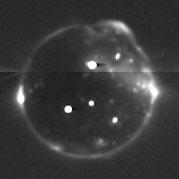New Horizons Io in Eclipse
In the darkness, only glowing hot lava, auroral displays in Io's tenuous atmosphere and the moon's volcanic plumes are visible. The brightest points of light in the image are the glow of incandescent lava at several active volcanoes. The three brightest volcanoes south of the equator are, from left to right, Pele, Reiden and Marduk. North of the equator, near the disk center, a previously unknown volcano near 22 degrees north, 233 degrees west glows brightly. (The dark streak to its right is an artifact.)
The edge of Io's disk is outlined by the auroral glow produced as intense radiation from Jupiter's magnetosphere bombards the atmosphere. The glow is patchy because the atmosphere itself is patchy, being denser over active volcanoes. At the 1 o'clock position the giant glowing plume from the Tvashtar volcano rises 330 kilometers (200 miles) above the edge of the disk, and several smaller plumes are also visible as diffuse glows scattered across the disk. Bright glows at the edge of Io on the left and right sides of the disk mark regions where electrical currents connect Io to Jupiter's magnetosphere.
New Horizons was 2.8 million kilometers (1.7 million miles) from Io when this picture was taken, and the image is centered at Io coordinates 2 degrees south, 238 degrees west. The image has been heavily processed to remove scattered light from Jupiter, but some artifacts remain, including a horizontal seam where two sets of frames were pieced together. Total exposure time for this image was 56 seconds.Relevante Bilder
Relevante Artikel
Marduk (Io)Der Marduk ist ein Vulkan auf dem Jupitermond Io. Benannt wurde er 1979 nach der sumerischen Gottheit Marduk. In jenem Jahr wurden von der Raumsonde Voyager 1 erstmals aktive Vulkane auf Io nachgewiesen. Marduk wurde dabei als Quelle einer Eruptionssäule ausgemacht. .. weiterlesen

